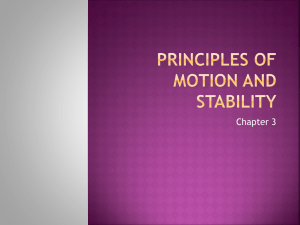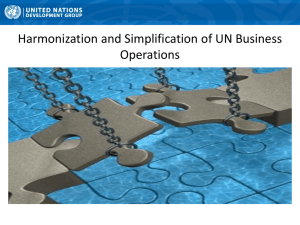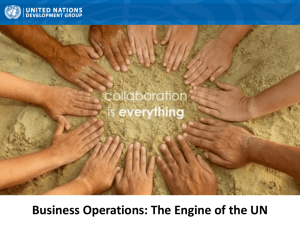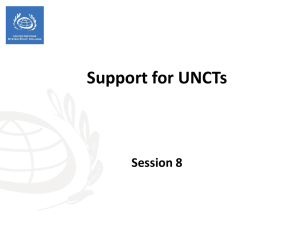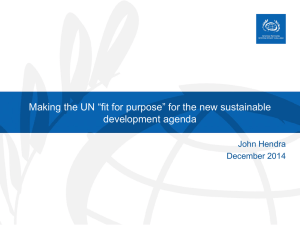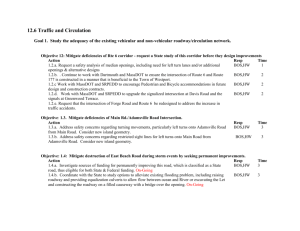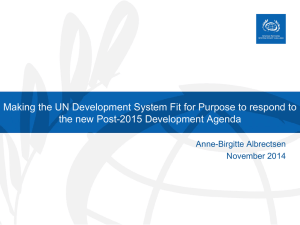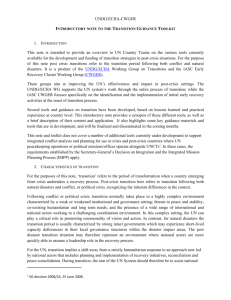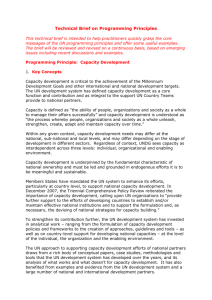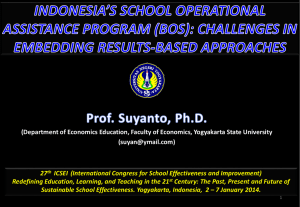Business Operations Strategy
advertisement
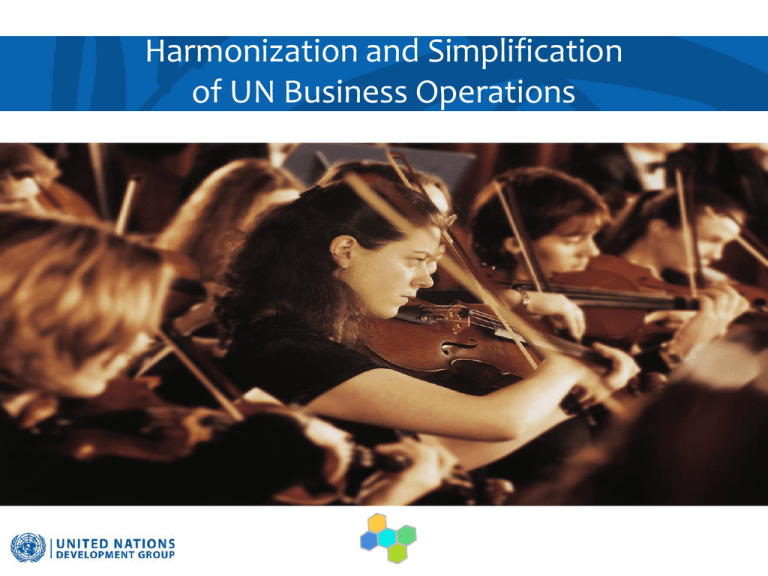
Harmonization and Simplification of UN Business Operations General Outline QCPR 2013-2016 Delivering as One The QCPR gives intergovernmental recognition of the “Delivering as One” model for the first time, though it remains a voluntary option. The QCPR requests the UN system to: Develop an integrated package of support to DaO countries including standard operating procedures (SOPs) and DaOspecific guidance; and Identify and address challenges and bottlenecks at the HQ (and country) level. QCPR and Business Operations 11 mandates for H-BO QCPR 2013-2016- Business Operations Increased use of national public and private systems Consolidation of support services Prioritize the availability of financial and human resources (Feasibility Study) ERP Interoperability Common and standardized system of cost control Decision power delegated to OMT Funding mechanisms for innovation Reduce the nr. of parallel project implementation units Greater collaboration in procurement Redirect efficiency savings into programmes Establishment of common premises Operationalization QCPR SOPs to be established for the second generation of DaO countries: Development of DaO specific guidance by the UNDG Working Mechanisms in collaboration with the HLCM Networks where relevant. Dissemination of the SOPs, training and capacity building for the roll-out of the second generation of Delivering as One. How does this translate into reality? QCPR UNDG Country and regional level implementation UNDG Strategic Priorities 20132016 SA Equivalent documents HLCM HLCM Strategic Priorities 20132016 Standard Operating Procedures (SoPs) DaO Harmonization Policy, Rules and Regulations Standard Operating Procedures for DaO Government of Programme Country One Leader* Resident Coordinator and UN Country Team Results Results Results Results Results Group Group Group Group Group Operations Management Team Country Communications Group Government and UN Joint Steering Committee One Budgetary Framework One Programme Medium Term Common Budgetary Framework UNDAF Joint Resource Mobilization Strategy Joint Results Groups’ Annual or Biannual Work Plan(s) One Fund and funding allocation mechanism Operating as One Business Operations Strategy (BOS) Monitoring Communicating as One Joint Communications Strategy Finance and Audit Common Premises Human Resources HACT Common Tools ICT Common Messaging and Advocacy Transport and Logistics Procurement One UN Country Results Report Standard Operating Procedures for DaO Operating as One HQ and Country Level Actions Components: 1. 2. 3. 4. 5. 6. 7. 8. 9. Business Operations Strategy (BoS) country level common procurement; common logistics and transport; common ICT; common HR; common audit; common finance; harmonized approach to cash transfers (HACT); and common premises. What is the Business Operations Strategy 1. Derives partially from UNDAF/programmes; 2. Voluntary instrument to be used at the country at level by UNCTs/OMTs; 3. Developed in conjunction with the UNDAF; 4. Covers Joint Business Operations initiatives; 5. Provides strategic, medium term focus, same cycle as the UNDAF; 6. Provides the basis for Monitoring, Evaluation and Reporting of Business Operations; 7. Provides the basis for BO Budgetary Framework and Resource Mobilization. What is the Business Operations Strategy HLCM Data, Policy Input Proc ICT HR Harmonised BO policies, procedures … FIN UNDG Country level solutions UNCT UNCT UNCT UNCT UNCT UNCT UNCT B O S What is the BoS? BoS = ScalablePick and chose service lines as locally needed Why do the Business Operations Strategy 1. Enhanced linkages Programmes and Operations 2. Reduced Costs • Reduction of duplication of work processes; • Reduction of transaction costs; 3. Enhanced Quality of Business Operations; 4. Enhanced operational focus and prioritization of investment in Business Operations. 5. Enhanced ability to track and report on results beyond a single yearenhanced Management Information BoS pilots (2013) 14 pilots, 4 self starters End date pilot October 2013 LIC countries, MIC and Post Conflict Countries Support UNDG and HLCM- Technical, QA, Mission, Political Review pilots Q3 2013 Revised guidance BoS Business Operations Strategy Approach Scoping the BoS Flexibility- based on in country capacity and need, the UNCT/OMT can select multiple or just one outcome area (ex. Procurement); Time Requirement: 40-50 hours (4-5 days) over a 5 year cycle to develop the draft BoS, including analysis; Time requirement may be higher or lower depending on the scope of the BoS (depends on capacity available and need). How to design a BoS Operations Analysis: Baseline Analysis Needs Analysis Requirement Analysis Cost Benefit Analysis Prioritization Harmonized Business Operations Medium Term Results Framework (incl. costing) Annual Work Planning Monitoring and Evaluation Framework OMT Work Plans Feedback Loop BoS 1. 2. 3. 4. Milestones BoS development
